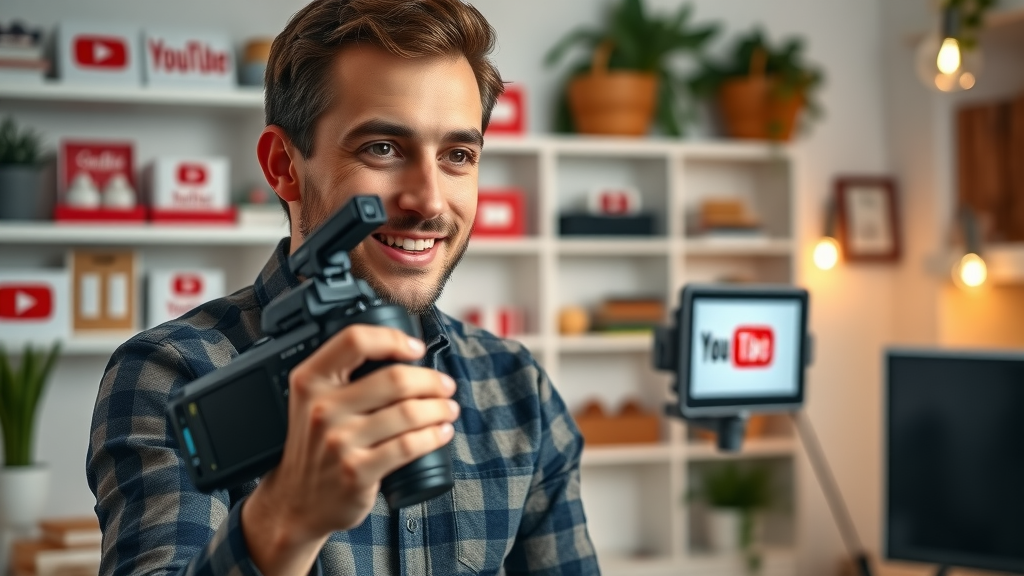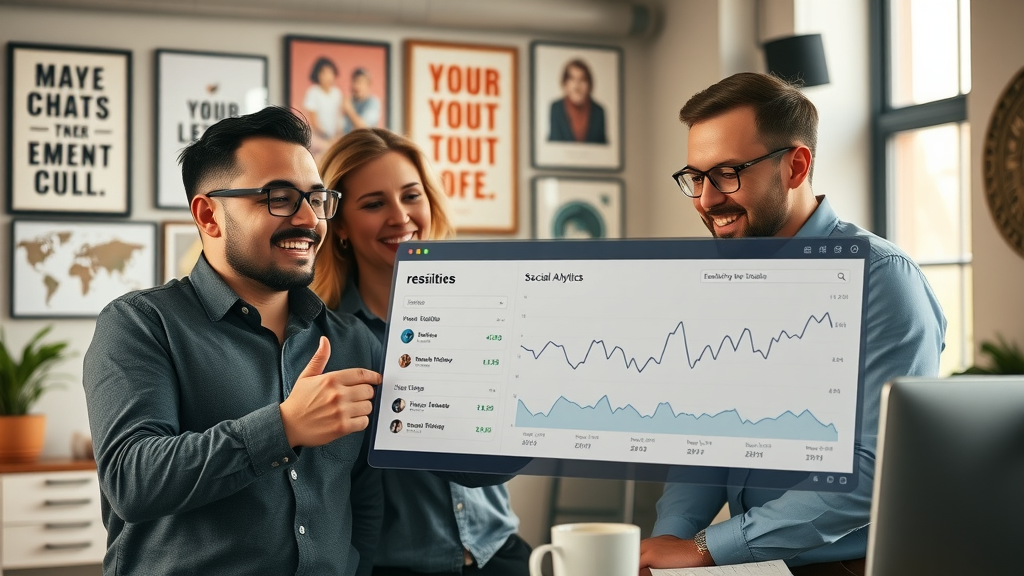Which Social Media Platforms for Small Business Drive Results?


Did you know? Almost 75% of small businesses say social media platforms are essential for their growth—yet many still pick the wrong platforms or misuse them, missing out on substantial revenue and customer engagement opportunities.
Maximizing Social Media Platforms for Small Business: Surprising Statistics That Will Change Your Approach
“Nearly 75% of small businesses report that social media platforms are vital for growth—yet most still choose the wrong channels.”
For today’s small business owner , choosing the right social media platform is no longer optional—it’s crucial. With billions of active users spending hours daily on social media channels, the power to shape your brand and reach potential customers is unprecedented. Yet, despite this potential, most small businesses either spread themselves too thin or select platforms that don’t match their goals, wasting resources in the process.
Real-world studies and marketing strategy experts show that success hinges on knowing where your target audience spends their time and what kind of media platform aligns best with your business goals. In 2024, the competition for attention on these platforms has never been fiercer, making it essential to understand both the strengths and weaknesses of each major social media platform for small business . Let’s break down what matters, with up-to-date statistics and expert-backed recommendations designed to maximize your social media presence.
Unlock Success: How Social Media Platforms for Small Business Empower Growth
- Discover key social media platforms for small business —understand their strengths, weaknesses, and audience specifics.
- Identify which social media platform is best aligned with your small business goals.
- Explore actionable media marketing tips and strategies for today’s leading platforms.
- Learn what rules and content strategies drive results for small businesses in 2024.
Understanding Social Media Platforms: Foundation for Modern Small Business Marketing
The Evolution of Social Media and Media Platforms for Business

Over the past two decades, social media platforms have revolutionized how small businesses connect with customers. From the early days of MySpace to Facebook’s rise as a dominant media site , and now to visual-first media platforms like Instagram and TikTok, the landscape is continually evolving. Platforms fine-tune their algorithms, introduce new features, and cater to shifting user preferences—placing new opportunities (and challenges) right at the fingertips of small business owners .
In 2024, having a presence on the right social media channels is about more than just posting updates. The integrated tools for e-commerce, advanced video content creation, and personalized targeted ad options mean your brand can interact more easily with potential customers and build meaningful relationships that convert. Understanding the journey from static forums to dynamic video-driven media platforms provides a roadmap for leveraging the very best in modern media marketing .
Social Media Presence: Why Small Businesses Can’t Ignore It
Ignoring the call to create an active social media presence has consequences. With nearly every competitor online, failing to claim and manage your profiles on top social media sites means missing out on brand awareness , customer service touchpoints, and powerful networking opportunities. Consider the stats: platforms like Facebook and Instagram each have billions of monthly active users , a true goldmine for targeted engagement if used properly.
A robust media presence also streamlines direct communications with both loyal and new customers. Questions, testimonials, and complaints received via Facebook Messenger or Instagram Direct can be handled in real time—boosting your customer service reputation. Startups and established brands alike find that media channels now function as public storefronts, providing social proof and community validation.
How Media Sites Shape Target Audience Engagement
Every media site attracts a different audience with distinct behaviors. For instance, TikTok favors humor, trends, and fast-paced video content among younger demographics, while LinkedIn is a haven for professional networking, B2B leads, and industry expertise. Choosing the right media platform allows for precision targeting and the ability to speak directly to your target audience —whether you prioritize direct sales, thought leadership, or community growth.
Strategically engaging on the right social network also means your brand can maximize ROI by delivering the right content at the right time. Successful small business owner s research platform demographics, analyze active users trends, and develop content strategies specifically designed to spark dialogue, encourage sharing, and increase visibility in feeds.
Choosing the Best Social Media Platforms for Small Business: Key Factors
Analyzing the Target Audience on Social Media Platforms
Before launching a social media campaign, every small business must identify where their target audience spends the most time. Facebook still dominates with its broad reach among adults of all ages, but platforms such as Instagram, TikTok, and Pinterest attract younger, more visually engaged audiences. LinkedIn is the go-to professional network for B2B businesses.
Take time to research analytics reports from each social media channel . Tools like Facebook Insights, Instagram Analytics, and Pinterest Business dashboards provide deep dives into user age, location, interests, and engagement habits—allowing you to craft content and media marketing messages that resonate most with your specific crowd.
Evaluating Media Platform Features for Small Business Growth

Every media platform offers different tools—stories, live video, direct messaging, in-app shops, community groups, and more. Successful small businesses evaluate which features align best with their business objectives. For instance, e-commerce brands thrive on Instagram Shoppable posts, while service providers may turn to Facebook groups or LinkedIn articles.
Consider your team’s skills and resources. Are you equipped to create regular video content , or is static imagery your strength? The correct platform will offer you tools that make your life easier and make your brand look polished without overreaching. Consistency in content creation and engagement is essential to build your media presence and drive growth.
Social Media Marketing Strategies: Aligning Platform and Goals
Aligning your social media marketing plan with specific business goals is fundamental. If you’re prioritizing brand new leads, LinkedIn or Facebook Ads may be the right fit. Visual brands should focus on Instagram, TikTok, or Pinterest for viral-worthy content. Blending the right media platform with tailored content ensures you aren’t just shouting into the void but engaging your target audience in meaningful ways.
Review your short- and long-term objectives. Is your aim to raise awareness, drive sales, or increase newsletter signups? Set realistic KPIs for each social media platform based on the platform’s audience behavior, and track results using built-in analytics.
Top Social Media Platforms for Small Business: Strengths, Weaknesses, and Results
| Platform | Monthly Active Users | Cost to Join | Ad Options | Engagement Potential |
|---|---|---|---|---|
| 2.9B+ | Free | Extensive—including targeted ads, custom audiences | High for B2C/B2B | |
| 2B+ | Free | Story ads, shoppable posts, influencer collaborations | Very High for Visual Brands | |
| 950M+ | Free | Sponsored content, InMail campaigns | High for B2B | |
| Twitter/X | 450M+ | Free | Promoted tweets, instant engagement | Moderate—fast-paced trending topics |
| TikTok | 1.1B+ | Free | In-feed video ads, challenges | Extremely High—viral short-form content |
| 460M+ | Free | Promoted Pins | High—DIY, lifestyle, fashion/food | |
| YouTube | 2.5B+ | Free | Video pre-roll, channel memberships | Very High—searchable, evergreen content |

Facebook as a Social Media Platform for Small Business
Facebook remains the most versatile media platform for small business owners. With advanced targeting, massive monthly active users , and a rich feature set—including groups, events, marketplace, and robust facebook ad options—brands can reach almost any target audience . Its media presence strength lies in fostering community, enabling direct messaging, and facilitating e-commerce.
However, organic reach has declined, and competition for attention is fierce. Paid options such as targeted Facebook Ads provide strong visibility and conversion, especially when campaigns are tailored to your audience’s behaviors and interests. Combining facebook ad placement with creative video content and engaging community posts delivers results for most niches.
Instagram for Small Businesses: Visual Media Marketing Power
Instagram is the go-to media channel for brands centered around visual storytelling. Fashion, beauty, food, travel, and lifestyle small businesses thrive with the platform’s shoppable posts, story features, and influencer collaborations. Instagram excels at reaching millennials and Gen Z audiences with visually stunning content and interactive stories.

What sets Instagram apart is its robust e-commerce integration. Features like one-click purchases and Instagram Checkout enable brands to convert discovery straight into sales. High-engagement video content —including Reels and Stories—make it easier for brands to go viral, maximize their media presence , and stay top-of-mind for their target audience .
LinkedIn: Leveraging This Professional Network for Small Business Success
LinkedIn’s primary strength is its credibility and professional focus. It is the top professional network for B2B small business owners , freelancers, and service providers wanting to connect with industry peers, recruit talent, or drive corporate partnerships. The platform’s robust targeting tools for sponsored content and direct InMail campaigns enable precise outreach.
Businesses leveraging LinkedIn effectively often establish thought leadership through articles, participate in niche groups, and use analytics to optimize lead generation. For social media marketing goals like partnership building or establishing expertise, LinkedIn offers unique visibility and authority that can’t be matched by more casual platforms.
Twitter/X: Real-Time Engagement on Social Media Platforms
Twitter (now X) specializes in fast, real-time updates, customer service, and industry conversation. It’s an excellent platform for sharing news, product launches, and live event updates with a broad but fast-paced target audience . Hashtags and trending topics offer fast amplification for timely content.
Small businesses use Twitter to humanize their brand, address customer concerns quickly, and join relevant discussions within their niche. The limited post length and fast-moving feed require concise messaging, but successful brands benefit from instant reach and viral moments.
TikTok and Short-Form Video Content: Media Platform for Viral Reach

TikTok has taken the social media world by storm, particularly among Gen Z and younger millennials. Its algorithm rewards creativity, humor, and genuine connection, making it the best platform for viral short-form video content . Small businesses can gain massive attention with behind-the-scenes videos, tutorials, employee spotlights, or creative storylines.
The platform supports robust audience targeting for advertising, native shoppable content, and collaboration with influencers who can launch a product or service into trending status. For media marketing strategies targeting rapid growth or younger demographics, TikTok’s potential is virtually unmatched.
Pinterest: Niche Social Media Site for Small Business Inspiration
Pinterest functions as both a search engine and a social platform, best suited for creative, DIY, lifestyle, food, and fashion brands. It’s a visual discovery tool with high-intent users—people seeking inspiration for future projects and purchases. Pins can drive long-term, evergreen traffic to product pages, blogs, or e-commerce shops.
Promoted Pins (ads) on Pinterest target specific interests or demographics, allowing for highly optimized campaigns. For small businesses with visually appealing products and repeatable ideas (recipes, crafts, décor tips), Pinterest provides an evergreen content advantage that amplifies traffic and sales over time.
YouTube: Long-Form Video Content and Searchability for Small Businesses

As the world’s largest video search engine, YouTube offers unparalleled reach for video content . Small businesses establish authority, explain complex concepts, and connect emotionally with audiences through how-tos, behind-the-scenes features, reviews, interviews, and more.
The platform’s searchability, paired with evergreen video libraries, makes it a go-to for educational brands or those with ongoing content needs. Successful small business creators optimize video SEO, promote subscription and sharing, and leverage analytics to refine their approach for maximum engagement and discoverability.
Other Niche Social Media Sites Worth Considering
Depending on your industry and audience, platforms such as Reddit (for community discussions), Snapchat (for ephemeral messaging), or Clubhouse (for audio/voice engagement) may provide additional opportunities. Always conduct research to determine if your target audience is active there and if the platform’s tools align with your objectives.
Developing a Winning Social Media Marketing Strategy for Small Businesses
Set SMART Goals for Social Media Platform Success

The SMART framework—Specific, Measurable, Achievable, Relevant, Time-bound—provides one of the best approaches for small business owners creating a social media marketing strategy . For example, rather than “get more followers,” a SMART goal might be “increase Instagram followers by 15% in three months through two weekly Reels and one Story per day.”
Setting such objectives ensures every action taken on your chosen media platform supports clear, tracked progress. Consistent evaluation allows for intelligent pivots, resource allocation, and proof of ROI.
Content Strategy: Balancing Video Content, Stories, and Static Posts
Social media success depends heavily on content diversity. Balance video content , static images, carousels, stories, and live streams to reflect both audience preferences and platform strengths. Platforms like Instagram and TikTok demand dynamic videos and brief, engaging narratives, whereas LinkedIn and Facebook may reward longer-form educational content.
Reviewing analytics to determine which formats generate the most engagement can turn a struggling media presence into a lead-generating powerhouse. Never underestimate the power of user-generated content or interactive features like polls and quizzes to inspire participation from your target audience .
Selecting the Right Platforms to Optimize Media Presence
Quality over quantity wins in 2024. Instead of spreading yourself thin over every media site , focus on 2-3 social media platforms for small business that best align with your goals, content abilities, and audience location. Regularly auditing your channels helps avoid wasted effort and ensures sustained media presence .
Developing platform-specific strategies optimizes engagement: post video tutorials on YouTube, run flash sales on Instagram Stories, and publish industry thought leadership on LinkedIn. Adapt your tone, visuals, and posting frequency to each channel’s unique culture and user expectations.
Integrating Social Media Platforms for Small Business: Real-World Case Studies
- Case Study: Facebook and Instagram Combined Campaigns – With aligned visual branding and linked ad accounts, this dual-platform campaign increased brand awareness and sales for a local boutique.
- Case Study: LinkedIn B2B Lead Generation for Small Businesses – A consulting agency generated 300% more qualified leads by consistently publishing LinkedIn articles and sponsoring targeted InMail campaigns.
- Case Study: Video Content Virality on TikTok – A food truck’s quirky recipe shorts amassed over 1M views, tripling followers and sparking national media attention—all via TikTok’s native editing tools and trend participation.

“Diversifying across multiple social media platforms provides greater customer touchpoints and builds a robust media presence.”
Social Media Advertising: Maximizing Results with Facebook Ads and Beyond
Facebook Ad Strategies for Small Business Growth
Facebook Ads allow small business owners to target users based on location, interests, and behaviors—making every ad dollar count. Remarketing campaigns re-engage visitors, while custom audiences nurture loyalty. Dynamic formats, video, carousel ads, and call-to-action buttons can dramatically boost results when tailored to the target audience .
Use A/B testing to optimize your creatives, headlines, and calls to action. Incorporate lead magnets (such as downloadable guides or discount codes) for fresher leads and higher conversion rates.
Instagram and Pinterest Paid Media Platforms
Both Instagram and Pinterest offer paid ad tools suited for visually engaging brands. Instagram’s Story Ads blend seamlessly into organic content, while Pinterest’s Promoted Pins catch users at the moment of inspiration. For small businesses , leveraging these ads to highlight new products, run time-limited promotions, or boost top-performing posts stretches your marketing budget further.
Optimize your campaigns by using platform-specific features, such as product tags or keyword-rich descriptions, to raise click-through and conversion rates.
Retargeting Audiences Across Social Media Sites
Retargeting lets your brand “follow” users who’ve interacted with your website or content across the web, providing persistent visibility. Facebook, Instagram, and Pinterest all allow for pixel-based retargeting campaigns—serving ads to both warm and cold audiences. These strategies consistently lift conversion rates, keeping your brand top-of-mind when your target audience is most ready to buy.
This persistent approach can make the difference in crowded marketplaces, nudging hesitant customers back to complete their purchase or inquiry.
Measuring ROI on Social Media Platforms for Small Business Success
Performance Metrics Every Business Owner Must Track
The key to sustainable media marketing is transparency in results. Essential metrics include reach, impressions, follower growth, post engagement, click-through rates, and—most critically—conversions and sales generated from social media platforms . For service-based businesses, track bookings or inquiries linked back to specific campaigns or content.
By consistently tracking and reviewing these data points, a small business owner clearly understands which media channel efforts drive revenue and which require adjustment.
Using Analytics Tools for Social Media Marketing

Leverage built-in tools (such as Facebook Insights, Instagram Analytics, Google Analytics, and Pinterest Analytics) to monitor post performance and campaign ROI. Third-party platforms (like Hootsuite, Buffer, or Sprout Social) provide even deeper insights for multi-channel management. These dashboards centralize your data, making it simple to compare the effectiveness of each social media site and fine-tune your marketing strategy .
Invest in regular reporting reviews and adjust your tactics based on what works. Metrics don’t just track progress—they also inform future strategies for scaling your small business ’s media presence.
People Also Ask: What is the best social media platform for small businesses?
The best social media platform for small businesses depends on your target audience, product, and resources. Facebook and Instagram lead for reach and ads; LinkedIn excels in B2B; while TikTok and Pinterest are ideal for visual and lifestyle brands.
People Also Ask: What social media should a small business use?
A small business should use social media platforms where their customers are active. Typically, Facebook, Instagram, and LinkedIn offer great starting points; expanding to TikTok or Pinterest depends on product relevance and content style.
People Also Ask: What is the 5 5 5 rule on social media?
The 5 5 5 rule encourages businesses to comment on 5 posts, share 5 pieces of content, and create 5 original posts weekly. This boosts engagement and presence on social media platforms for small business.
People Also Ask: What is the 50 30 20 rule for social media?
The 50 30 20 rule advises a content mix: 50% valuable/educational content, 30% curated/shared content, 20% promotional content—ideal for sustainable social media marketing for small businesses.
Advanced Tips: Elevating Social Media Marketing for Small Businesses
- Tailor content to each media site’s strengths.
- Engage your audience consistently, optimizing for the latest algorithms.
- Repurpose video content across media platforms to maximize ROI.
- Invest in media marketing training or tools to streamline your social media presence.
Most Common Mistakes with Social Media Sites for Small Businesses—and How to Avoid Them
- Ignoring your target audience’s preferred platforms
- Focusing on too many platforms at once
- Neglecting to measure results and pivot strategy
- Inconsistent posting and lack of content variety
Frequently Asked Questions
- How often should a small business post on social media platforms? Most experts recommend posting at least 3-5 times per week on your chosen platforms for consistent engagement, but quality always trumps quantity. Adjust frequency based on platform standards and audience responsiveness for your niche.
- Which social media site drives the most conversions? Facebook and Instagram generally lead in conversions due to their advanced targeting tools and massive user bases. However, TikTok and Pinterest can outperform for visually-driven products or viral marketing efforts when aligned with the right audience.
- Is video content necessary for small businesses? Yes, video content is crucial for most platforms. It captures attention, boosts engagement, and is favored by algorithms on Instagram, TikTok, Facebook, and YouTube. Even “low-budget” videos authentic to your brand can generate great reach and results.
- How can a business owner learn social media marketing effectively? Take advantage of free online courses, attend webinars, and follow top industry blogs. Practice consistently, analyze your metrics, and experiment with new features or tools offered by each media platform to refine your skills.
- What tools help manage media presence efficiently? Platforms like Hootsuite, Buffer, or Sprout Social allow you to schedule posts, monitor engagement, and organize analytics in one place so you can maintain a robust media presence without constant manual input.
Key Insights for Small Businesses Using Social Media Platforms
- Choosing the right social media platform can double engagement rates.
- Effective media marketing builds brand loyalty and accelerates sales.
- Consistency yields the most robust media presence for small businesses.

Achieve Your Goals: The Next Step for Small Businesses on Social Media Platforms
Take immediate action—evaluate your current social media platforms , define SMART goals, and focus your media marketing on 2-3 key channels that most align with your brand and audience. Consistency and continuous learning are your allies for 2024 success.
Selecting the right social media platforms is crucial for small businesses aiming to enhance their online presence and drive growth. Each platform offers unique features and caters to specific audiences, making it essential to align your choice with your business goals and target demographics.
Facebook remains a versatile platform with over 2.9 billion monthly active users, making it ideal for businesses seeking a broad audience. It offers comprehensive advertising options, including targeted ads and custom audiences, facilitating community building and customer engagement. ( reckon.com )
Instagram , with over 2 billion monthly active users, is perfect for brands focusing on visual storytelling. Its features like Stories, Reels, and Shopping allow businesses to showcase products creatively, making it particularly effective for industries like fashion, food, and lifestyle. ( reckon.com )
LinkedIn serves as the premier platform for B2B marketing and professional networking. It’s invaluable for businesses aiming to establish industry connections, recruit talent, and share thought leadership content, thereby enhancing credibility and trust within professional circles. ( digitalbrandingblocks.com )
TikTok has rapidly become a valuable platform for small businesses targeting younger demographics. Its algorithm favors creative, short-form videos, providing opportunities for businesses to reach a wide audience quickly. However, it’s important to note that potential regulatory changes may impact its availability in certain regions. ( reuters.com )
Pinterest acts as a visual search engine, making it ideal for businesses in design, fashion, home décor, and crafts. Users often use Pinterest for planning and research, providing businesses the opportunity to influence purchasing decisions through visually appealing content. ( thesmallbusinessblog.net )
YouTube offers a platform for long-form video content, allowing businesses to create tutorials, product demonstrations, and brand storytelling. Its vast audience and searchability make it suitable for businesses aiming to establish authority and engage with customers through informative videos. ( thesmallbusinessblog.net )
By understanding the unique strengths of each platform and aligning them with your business objectives and target audience, you can develop a strategic social media presence that drives engagement and growth.





